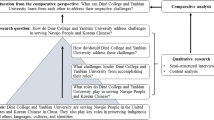
Overview
- First book-length comparative study of Tribal Colleges and Universities (TCUs) in the US and Chinese Ethnic Minority-Serving Institutions (EMSIs) in China
- Based on interview data from over two dozen TCU and EMSI administrators and content experts
- Provides a comprehensive demographic overview of American Indians and Alaska Natives (AIANs) and Chinese Ethnic Minorities (CEMs)
Part of the book series: International and Development Education (INTDE)
Access this book
Tax calculation will be finalised at checkout
Other ways to access
About this book
This book presents a comparative study of the history and development of indigenous and ethnic higher education in the US and China. The author focuses on institutions serving American Indians and Alaska Natives (AIANs) and Chinese Ethnic Minorities (CEMs), such as Tribal Colleges and Universities (TCUs) in the US and Ethnic Minority Serving Institutions (EMSIs) in China. Chapters center voices within indigenous and ethnic education, including experts, senior administrators, and faculty members as well as AIAN tribal leaders and activists. These voices enrich the study and provide context to explore the issues and challenges surrounding ethnic and minority-serving higher education institutions today. Finally, the author addresses strategies and practices for the future which will better serve AIAN and CEM students and communities.
Similar content being viewed by others
Keywords
Table of contents (11 chapters)
-
Front Matter
-
Back Matter
Reviews
—Ka Ho Mok, Vice President and Lam Man Tsan Chair Professor of Comparative Policy, Lingnan University, Hong Kong
“Xiong’s work presents the realistic situations of ethnic minority-serving institutions in the US and China. It helps make TCU and EMSI stakeholders’ voices heard, not only by academia, but also by policymakers for the development of indigenous and ethnic higher education and the preservation of native cultures, languages, and traditions.”
—Wanhua Ma, Professor, Graduate School of Education, Peking University, China
“The succinct comparative analysis by Weiyan Xiong of higher education in select American Indian, Alaskan Native, and Chinese Ethnic Minority regions will position the reader to better understand how institutions serving them evolved, the challenges they encountered and suggestions for the future. Xiong’s meticulous research and thoughtful analysis renders a valuable contribution to our scholarship in this important field of study. It is a must read!”
—Stewart E. Sutin, Clinical Professor of Administrative and Policy Studies (retired), University of Pittsburgh, USA
“There are two biggest higher education countries in the world, the US and China. The former has a well-developed higher education system while the latter has the largest number of college students. How to treat minority students in the respective higher education system is an exciting and valuable topic for comparative study. In Xiong’s work, the historical development, challenges, and strategies of minority higher education in these two countries are deeply explored. This is a vitally important book not only for academic research but also for the dialogue among civilizations.”
—Bateer Chen, Professor, Zhou Enlai School of Governance, Nankai University, China
“I highly recommend this book at a time when attention has turned toward preserving and drawing upon culture, language, and local knowledge as a core mission of tribal colleges and universities and ethnic minority-serving institutions. Xiong’s comparative study of institutions serving American Indians, Alaska Natives, and ethnic minorities in China serves as a lens through which to view the successes and challenges of these institutions and provides a pathway to their sustainability and improvement. By representing the voices of scholars in the field, administrators and faculty, and students participating in these institutions, Xiong has provided external and internal perspectives on the cross-cultural experiences of institutions. Through his study, he creates a realistic picture of what it means to valorize indigenous knowledge as a powerful source of learning and development. Xiong concludes his comparative analysis by highlighting best practices for the improvement of tribal colleges and universities and of ethnic-minority institutions and provides a blueprint for a promising future.”
—Richard Donato, Professor and Chair, Department of Instruction and Learning, University of Pittsburgh, USA
Authors and Affiliations
About the author
Weiyan Xiong is Research Assistant Professor at Lingnan University School of Graduate Studies, Hong Kong. Formerly, he was Program Coordinator at the Institute for International Studies in Education at the University of Pittsburgh, USA, and Visiting Student Researcher at the Myers Center for Research on Native American Issues at the University of California, Berkeley, USA. He has published works on indigenous higher education; comparative, international, and development education; and faculty professional development.
Bibliographic Information
Book Title: Ethnic Minority-Serving Institutions
Book Subtitle: Higher Education Case Studies from the United States and China
Authors: Weiyan Xiong
Series Title: International and Development Education
DOI: https://doi.org/10.1007/978-3-030-55792-8
Publisher: Palgrave Macmillan Cham
eBook Packages: Education, Education (R0)
Copyright Information: The Editor(s) (if applicable) and The Author(s), under exclusive license to Springer Nature Switzerland AG 2020
Hardcover ISBN: 978-3-030-55791-1Published: 29 October 2020
Softcover ISBN: 978-3-030-55794-2Published: 29 October 2021
eBook ISBN: 978-3-030-55792-8Published: 28 October 2020
Series ISSN: 2731-6424
Series E-ISSN: 2731-6432
Edition Number: 1
Number of Pages: XXIII, 180
Number of Illustrations: 5 b/w illustrations
Topics: Ethnicity in Education, International and Comparative Education, Higher Education, Sociology of Education



